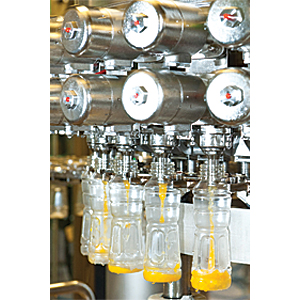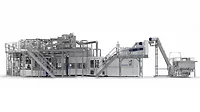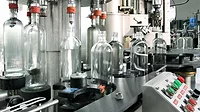Operations: Filler machines adapt to changing beverage trends
Machines adapt to changing beverage trends
It doesn’t matter whether you’re a glass half-empty or a glass half-full type of person, because it’s filler technology’s job to make sure the beverage container is always perfectly full. To do so, suppliers are constantly evaluating, modifying and updating their equipment to keep the filling process as efficient and effective as possible.

|
|
Krones Inc.’s FlexiFruit system is equipped to handle fruit pieces up to 10 cubic millimeters in size to fill beverages that require a juice and pulp mixture. |
For instance, SIPA North America Inc., Atlanta, has transitioned from the previously popular mechanical filler valves to electronically controlled valves, which the company notes are becoming more popular, to achieve the best possible filler accuracy. SIPA’s Isotronic P filler for carbonated mineral water, carbonated soft drinks, still water and clear juices; Unitronic P filler for micro-filtered milk, drinkable yogurt, still water, clear juice and alcohol beverages; and Bigfill filler machine for large PET containers of still water are all equipped with electronic valves with volumetric filling controlled by a magnetic flow meter placed on the filling valve, the company says.
“When the value of the product is important, we’re more and more working with electronic valves — valves that are really measuring the flow of the product — and they are extremely precise to [make sure] every bottle is receiving exactly the right amount of product,” says Marco Bottecchia, president of SIPA North America. “This is extremely important in order to keep control of the product.”
Bottecchia notes that filler accuracy is important to both the consumer and the beverage-maker. Consumers like to know they are getting the correct amount of product they pay for, and beverage-makers want to ensure they don’t exceed that amount, in order to save cost, he says.
Plus, more precise filling also can mean less product waste. Although previous filler technology might have resulted in spilling a little bit of product on the floor, fillers don’t want to see that type of waste now, says Tim Farnham, president of Buffalo, N.Y.-based SCI Solutions Inc.
One way for fillers to save money on waste is to use standardized beverage containers that hold exactly the same amount of product, Farnham says. SCI Solutions offers standardized punches for specific can sizes that help can manufacturers ensure that all cans are exactly the same size, which means fillers can pour the exact same amount of product into every can, essentially standardizing the filling process.
“You can dial your machine in, and once it’s dialed, it’s all in being more precise,” Farnham says. “The more precise we are, the faster we can run.”
Adding flexibility
Filler technology companies say that their customers are increasingly looking for more flexibility from a filling machine. For example, the ability to handle both high-acid and low-acid products on the same machine means that smaller filling companies can keep up with niche beverage trends, notes John Holloway, business development and sensitive products manager at Sidel Group, Norcross, Ga.
Sometimes changes in beverage type dictate a need for filler flexibility. For instance, an international trend toward using fruit pieces and pulps in beverages has increased demand for machines that fill both liquid juice and solid fruit pieces into the same container. For this purpose, Franklin, Wis.-based Krones Inc. offers its FlexiFruit system, which combines two filling carousels — one for fruit pieces and one for liquid. This separation minimizes pulp damage and results in homogenous, consistent pulp and juice mixes in every bottle, says Barry Fenske, filling division product manager at Krones. This simple, hygienic machine is equipped to handle fruit pieces up to 10 cubic millimeters in size and is designed to avoid post-dripping and filling inaccuracies, he says.
Packaging containers demand more flexibility from filler technology as well. To accommodate such needs, Waukesha, Wis.-based KHS USA Inc.’s Innosept Asbofill ABF filling machines can be converted to handle beverage bottles with 28-mm or 38-mm necks, depending on what type of bottle is being used in the filling run.
Vista, Calif.-based Accutek Packaging Equipment Co. Inc. says it rarely makes a filler machine designed specifically for one type of product or container. “Nearly every machine we make is adjustable to accommodate a wide range of products and container sizes with as minimal change parts as possible,” says Drake Chocholek, vice president of Accutek.
The company’s pinch-style fillers, like the Auto-Pinch 25 or Auto-Pinch 50, are inline fillers that utilize a simple adjustable pin indexing system that can accommodate round, square or a variety of other container shapes, the company says. On these machines, an operator can manage a container changeover in as little as five minutes, most of the time without tools, he adds.
Looking ahead
For insight into the future of beverage filler technology, Brian Wallace, director of Baltimore-based Adcor Industries’ packaging group, advises industry players to look at marketing trends in packaging.
“Everybody wants different sizes all the time,” he says. “It’s all about the consumer, and it’s all about the latest marketing, and the ability to respond to that is undeniably important.”
Future packaging designs will dictate what producers need from filler technology, which will drive advancements in the industry, he says. BI
Looking for a reprint of this article?
From high-res PDFs to custom plaques, order your copy today!





